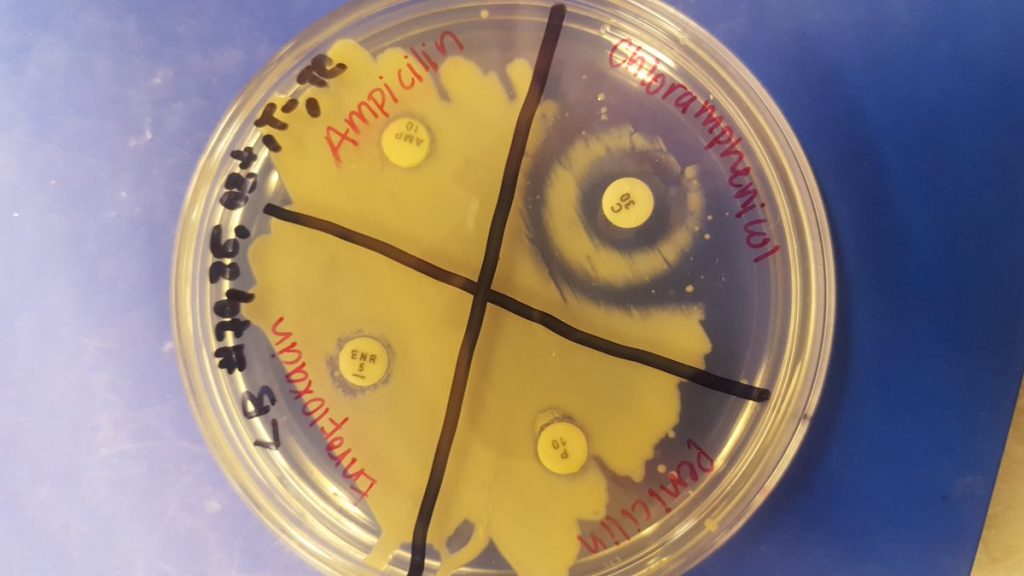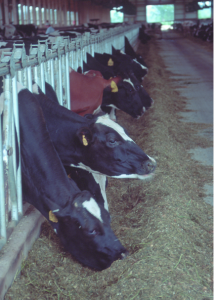In their just published paper in Environmental Science & Technology, “Tetracycline Resistance and Class 1 Integron Genes Associated with Indoor and Outdoor Aerosols,” Alison L. Ling, Norman R. Pace, Mark T. Hernandez, and Timothy M. LaPara have found that genes escape the indoor environment and can be found 2 km away. The abstract can be read and the article can be accessed here. (ES&T is not open access, but it is the most widely-read and respected journal in the environmental engineering community.
“…[Q]uantitative polymerase chain reaction (qPCR) was used to determine the abundance of tetracycline resistance and Class 1 integrase genes in aerosol samples collected from livestock farms, human-occupied indoor spaces, and outdoor air along the Rocky Mountain Front Range in Colorado, USA. [They] hypothesized that CAFOs and clinics may contribute significant concentrations of aerosolized resistance genes which can potentially spread via aerosol transfer.” They found that antibiotic genes escaping from two confined animal feeding operations (CAFO), one swine and one dairy, could be found in outdoor air 2 km distant from the CAFO.
“The widespread subtherapeutic use of antibiotics in animal feed has been controversial in the United States, since it has been considered a major source of antibiotic resistance to nearby soil and water, and is often considered to be unnecessary or avoidable.4,5 In general, hospitals and confined animal feeding operations (CAFOs) are assumed to be the most significant sources of antibiotic resistance because of their extremely high utilization
of antibiotics.”
While much of the Sloan Foundation’s Microbiology of the Built Environment Program focuses on characterizing microbes indoors (air, surfaces, dust, and water), this paper reports research, partially funded by the Sloan Foundation, that looked at genes escaping from the indoor environment and traveling as aerosols. The study found that CAFOs are a source of the relatively high abundance of airborne bacterial genes, “…a substantial fraction of which carry antibiotic resistance genes.”
The authors concluded that “…our recovery of antibiotic resistance genes from aerosols across different indoor environments has implications for public health, hospital quarantine measures, and indoor air quality.”
This study of airborne bacterial transport from indoors to outdoors reminds me of studies of SARS spread in the Amoy Gardens apartment complex in Hong Kong where the index case was in a building across a very large open area from a downwind building where many cases occurred. (See Ignatius et al, 2004, “Evidence of Airborne Transmission of the Severe Acute Respiratory Syndrome Virus,” NEJM:350:1731-1739.),


New at #microBEnet: “…antibiotic resistance genes may be transported via aerosols on local scalesâ€:
In their … http://t.co/XNJlmm5Hn7
RT @phylogenomics: New post at #microBEnet “…antibiotic resistance genes may be transported via aerosols on local scales http://t.co/uoID…
RT @phylogenomics: New post at #microBEnet “…antibiotic resistance genes may be transported via aerosols on local scales http://t.co/uoID…
RT @phylogenomics: New post at #microBEnet “…antibiotic resistance genes may be transported via aerosols on local scales http://t.co/uoID…
RT @phylogenomics: New post at #microBEnet “…antibiotic resistance genes may be transported via aerosols on local scales http://t.co/uoID…
<oh no!> “…antibiotic resistance genes may be transported via aerosols on local scales†http://t.co/YR4j70dRS1 via @microBEnet
Bummer about it not being open access. I am at home right now and do not have access to this paper.
RT @phylogenomics: New post at #microBEnet “…antibiotic resistance genes may be transported via aerosols on local scales http://t.co/uoID…
RT @phylogenomics: New post at #microBEnet “…antibiotic resistance genes may be transported via aerosols on local scales http://t.co/uoID…